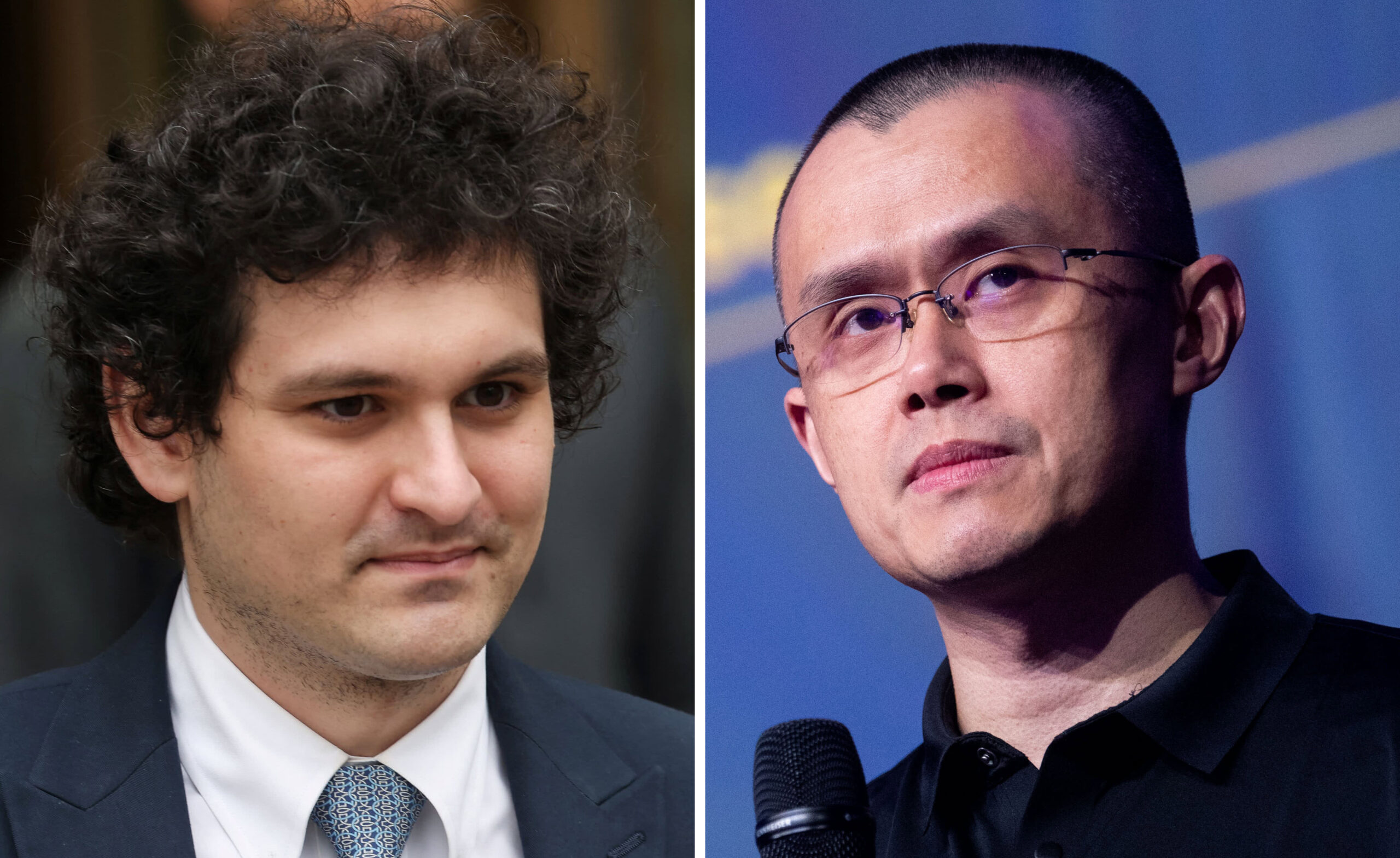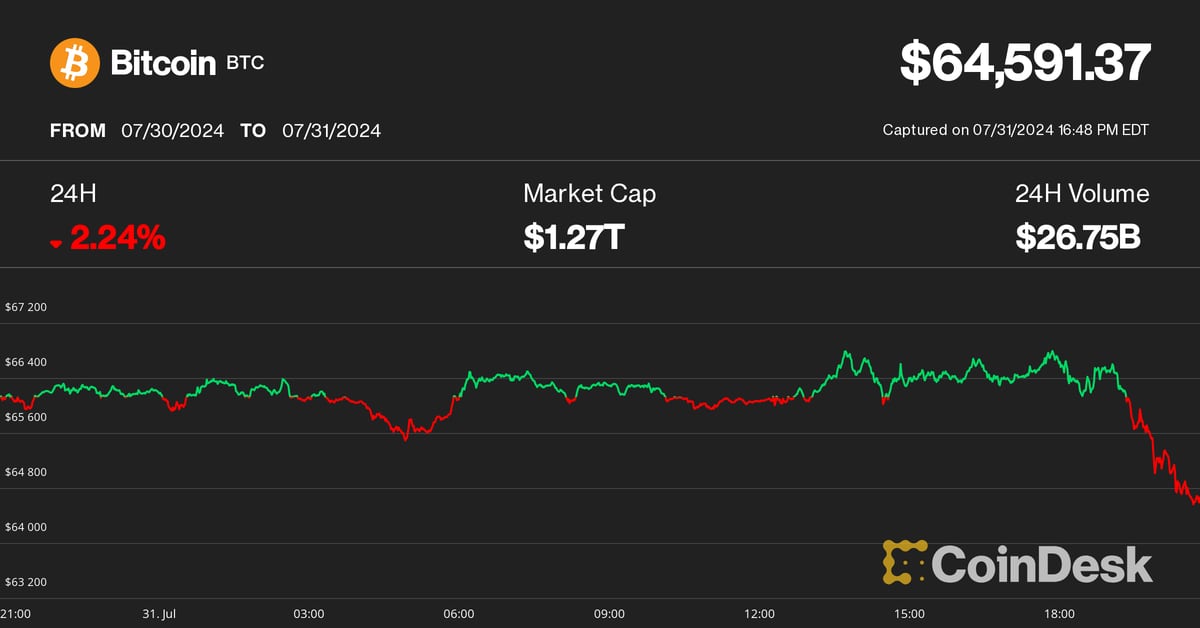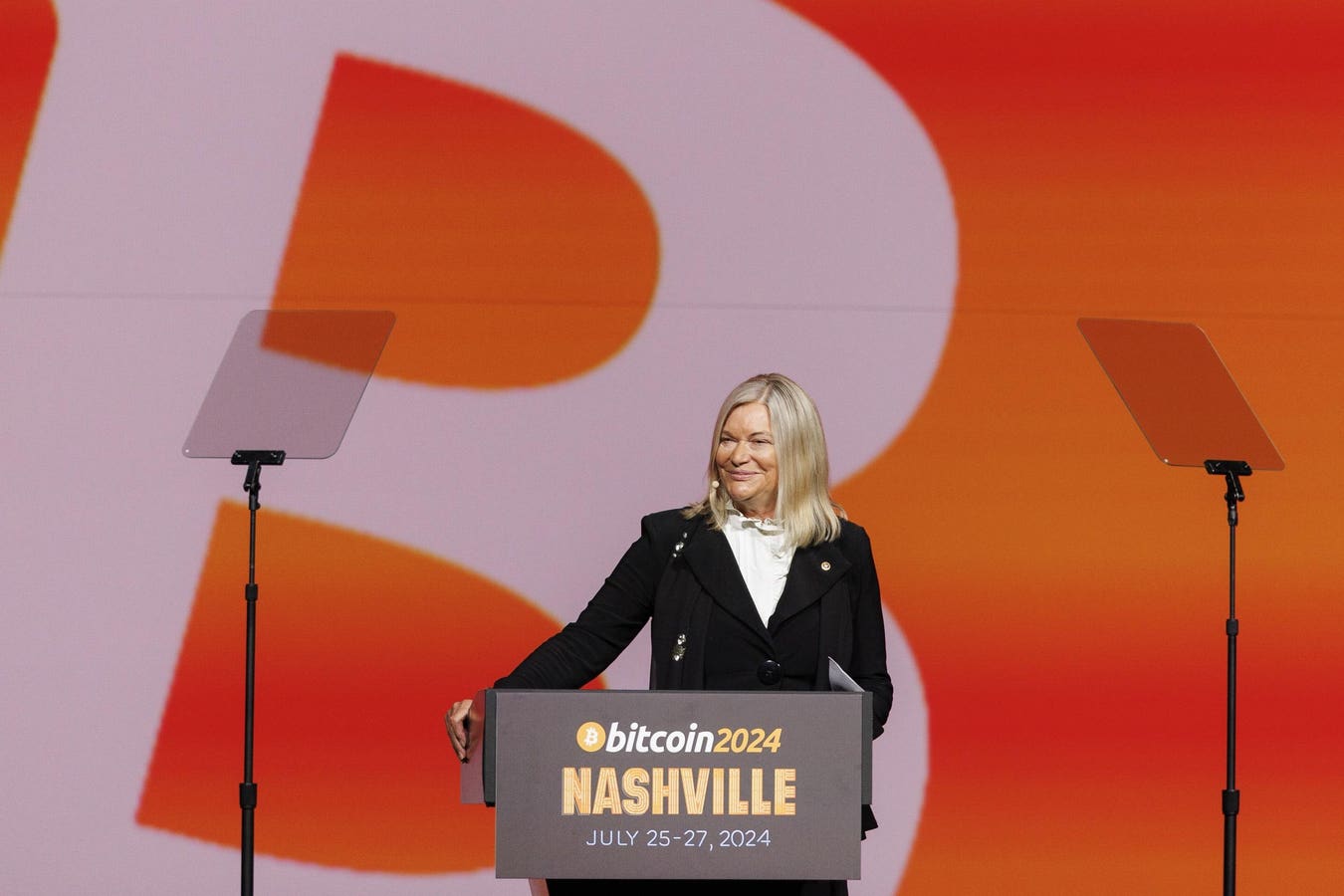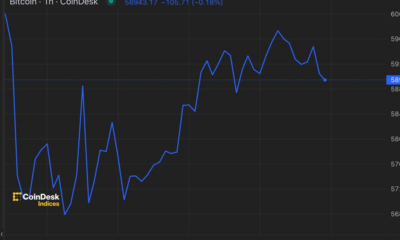Bitcoin
Inside the final prison verdict on an epic crypto CEO rivalry

- A longtime battle between cryptocurrency titans was brought to a close in federal court this past week when Binance founder Changpeng Zhao was handed a sentence of four months in prison.
- The criminal judgment was in stark contrast to the 25-year prison sentence FTX’s Sam Bankman-Fried received.
- The crypto kingpins shared a pulpit for years from which they preached the power of decentralized, digital currencies to the masses, but the difference in prison sentences highlights how they were nothing alike in business or in personal dealings.
Combination showing Former FTX CEO, Sam Bankman-Fried (L) and Zhao Changpeng (R), founder and chief executive officer of Binance.
Mike Segar | Reuters | Benjamin Girette | Bloomberg | Getty Images
An arch rivalry between one-time crypto titans was brought to a close at a federal courthouse in Seattle on Tuesday when Binance founder Changpeng Zhao was handed a sentence of four months in prison. A month earlier, on the opposite coast in downtown Manhattan, FTX’s Sam Bankman-Fried received a 25-year prison sentence for his crimes.
It seemed an underwhelming and somewhat anti-climactic finish to a protracted battle between Zhao and Bankman-Fried, two men who were legendary adversaries, as well as key stewards of the $2.2 trillion crypto sector.
For years, Binance’s Zhao and FTX’s Bankman-Fried preached the power of decentralized, digital currencies to the masses. Both were bitcoin billionaires who drove Toyotas, ran their own global cryptocurrency exchanges and spent much of their professional career selling the public on a new, tech-powered world order; one where an alternative financial system comprised of borderless virtual coins would liberate the oppressed by eliminating middlemen like banks and the overreach of the government.
Ultimately, both also helped crypto critics and regulators make the case that the skeptics had been right all along — the industry was rife with grifters and fraudsters intent on using new tech to carry out age-old crimes.
Bankman-Fried, 32, was convicted of seven criminal counts in early November, including charges related to stealing billions of dollars from FTX’s customers. Less than three weeks after Bankman-Fried’s conviction, 47-year-old Zhao pleaded guilty to criminal charges and stepped down as Binance’s CEO as part of a $4.3 billion settlement with the Department of Justice.
Yet, much else about the pair is starkly at odds — perhaps most notably, the 296-month difference in their respective prison sentences.
“Comparing CZ and SBF, both figures emerged as prominent in the cryptocurrency sector but under vastly different circumstances,” said Braden Perry, a former senior trial lawyer for the CFTC.
“The nature of their alleged crimes reflects different aspects of the ‘dark’ and illicit corners of crypto: CZ’s case seems to focus on regulatory and compliance failures, while SBF’s case hinges on direct financial misconduct and deception,” Perry said.
Indeed, the disparate consequences for the two former crypto CEOs lay bare that the pair was, in the end, nothing alike in business or in personal dealings.
It was the small things — the type of details that you don’t notice at first and are often difficult to articulate the significance of once you do — that betrayed the more notable differences between the two former CEOs.
Take Manfred, a worn stuffed animal that Bankman-Fried has carried around the world with him since birth, from California, to Hong Kong, to the Bahamas, and then back home to Palo Alto, where the FTX founder lived under house arrest until he was remanded to custody for tampering with witnesses.
The 32-year-old toy, which has lost much of its shape and identifying features, sat on the bed of his sparsely decorated room in his parents’ house on Stanford University’s campus in his final days before incarceration. It was a harmless prop at first glance, more a charming nod to an adolescent spirit than the sort of window into Bankman-Fried’s inner psyche that some of those who knew him would later attempt to turn it into.
Two of Bankman-Fried’s former colleagues and friends took turns at speculating on its meaning. One thought that SBF kept the stuffed animal close because “he doesn’t need to share Manfred with anyone,” according to reporting from “Going Infinite,” the Michael Lewis book that profiled Bankman-Fried. Another guessed, “I think it is very, very important for him to have an emotional attachment.”
Lewis himself writes that “Sam didn’t care about real animals” and that it had, in fact, been “an expected value calculation, rather than emotion, that had led him to go vegan.”
Bankman-Fried did have a history of intimacy issues. Part of it, according to his family, friends, work colleagues, criminal defense attorneys, and even Bankman-Fried himself, had to do with his inability to feel much of anything, for anyone, including romantic love interests.
FTX founder Sam Bankman-Fried leaves the U.S. courthouse in New York City on July 26, 2023.
Amr Alfiky | Reuters
His lawyers described him as often struggling socially, disclosing that in high school, Bankman-Fried “realized he was anhedonic, or unable to experience joy or pleasure.”
“As Sam describes it, he experiences negative emotions in ways that are not very different from many other people — neither much more extreme, nor much less negative. But he does not feel pleasure, or happiness, or joy, even when something very good happens to him,” a court filing in SBF’s criminal court docket reads.
Lawyers for Bankman-Fried added that it was not a disease or condition to be “cured,” but instead, “a fundamental aspect” of his identity. Lewis relayed an exchange with SBF in which Bankman-Fried said that smiling was the biggest thing that he “most weirdly” couldn’t do.
Bankman-Fried never married, has no children, and according to Lewis, moved himself and his company headquarters to the opposite side of the planet, twice, partly to avoid committing to his ex-girlfriend, ex-colleague, and the prosecution’s star witness against him: Alameda CEO Caroline Ellison.
The government’s case against him — which resulted in a unanimous guilty verdict in just a few hours despite it being a complicated month-long trial involving hundreds of exhibits and nearly 20 witnesses — was largely built upon the testimony of the people who knew Bankman-Fried best. The list included his former C-suite, ex-roommates, and ex-best friends going back to high school.
And so, Manfred took on new meaning, and began to embody much of what appeared to onlookers as a very lonely existence, in which the people closest to Bankman-Fried were the ones to seal his fate behind bars.
While Bankman-Fried’s parents were staunch defenders of their son in court, CZ, by contrast, had many who know him best leap to his defense. Zhao’s wife, his current lover, two of his five children, and dozens of Binance employees all penned the judge to plead for mercy in sentencing.
“I am a partner in the work of Changpeng Zhao (abbreviated CZ) and I am also the mother of his three children,” reads a note submitted by Yi He, a co-founder of Binance and Zhao’s current romantic partner. “Although the mainstream media tries to portray CZ as an evil bad actor, millions of community users and ordinary people regard him as a hero of the industry, because CZ has always insisted on justice.”
Changpeng Zhao, former CEO of Binance, arrives at federal court in Seattle, Washington, April 30, 2024.
David Ryder | Bloomberg | Getty Images
Zhao’s wife, Weiqing “Winnie” Yang called him a “self-made man” who “has never owed money to others and has not had any liabilities.” Yang added that Zhao has “taken the greatest care” of her and their shared children. Their daughter, Rachel Zhao, implored the judge “to consider her father’s positive attributes; to not define my father’s character solely through this one incident and consider the entirety of his character,” emphasizing that he was “the best father.”
Differences between the pair also showed up in the way they presented themselves.
Whereas Zhao maintained a military-style buzzcut, Bankman-Fried was known for his iconic and unwieldy mop of curls. CZ bought clothes on Amazon, but his look and demeanor were buttoned-up. SBF, who similarly opted for simple dress (usually a loose T-shirt and cargo shorts), appeared perpetually disheveled, whatever the occasion. At the beginning of his trial, SBF sported a fresh haircut and wore suits, but by its end, his curls were wild again. Zhao wore a fitted navy suit and light blue tie at his sentencing, versus the beige jailhouse jumpsuit donned by Bankman-Fried.
But perhaps the greatest distinction between the two relates to the command they held over those around them.
Zhao had an air of the consummate professional, with a strong appetite for total control of his sprawling enterprise. Bankman-Fried, who takes medication for the neuro-developmental disorder attention-deficit/hyperactivity disorder, sought a similar level of control, but admitted on the stand that mistakes were made, in part, because he was overwhelmed. Bankman-Fried’s psychiatrist unequivocally made clear to the judge that without prescribed medication, Bankman-Fried would experience a return of his symptoms and be “severely negatively impacted in his ability to assist in his own defense.”
Reuters reporting found that even as CZ’s crypto exchange diversified its hiring into traditional finance and regulatory talent pools, “Zhao’s tight control over his company was undiminished.” Binance set up more than 70 entities, and according to Reuters, Zhao personally controlled most of them.
Cryptocurrency exchange Binance founder and CEO Changpeng Zhao speaks at a Binance fifth anniversary event in Paris, France, July 8, 2022.
Staff | Reuters
Prosecutors similarly proved through testimony and evidentiary exhibits their narrative of Bankman-Fried quietly continuing to call the shots at his crypto hedge fund, Alameda Research. They showed that his decision-making power over the $32 billion crypto empire he built was absolute, and that all wrongdoing stemmed from decisions touched, or directly made by, Bankman-Fried himself. But unlike CZ, Bankman-Fried oversaw an organization with chaotic and falsified bookkeeping that ultimately led to the implosion of the companies he founded and the theft of billions of dollars of customer money.
And then there was the way that each looked to craft their public persona.
CZ was big on privacy. The letters submitted by his romantic partners and children were a rare inside look at Zhao’s personal dealings. And rather than take to mainstream media to share his defense, CZ clammed up and cooperated with the feds.
Shirking the advice of all counsel, Bankman-Fried went on a media blitz to talk about the implosion of his crypto empire. Many of those statements ultimately appeared in the government’s successful trial against him in October and November 2023.
“SBF resolutely did not settle, violated his bail conditions, spoke frequently to the press in his own favor and seemed to lack a display of genuine, heartfelt remorse even at his own sentencing,” said Yesha Yadav, law professor and associate dean at Vanderbilt University.
“Part of CZ’s deliberations in settling with Justice in November may have been precisely to make this point – that his conduct stands profoundly in contrast to the brazen behavior of SBF,” Yadav added.
In Seattle, Zhao’s sentencing was a relatively quiet affair, with a vibe that was more muted than the circus surrounding Bankman-Fried’s time in court.
“This proceeding looked and felt like the prosecution of a Wall Street executive,” said Mark Bini, a former state and federal prosecutor.
Zhao also expressed his remorse, accepting responsibility for his crimes and telling the judge he was sorry for his actions. It stood in stark contrast to Bankman-Fried’s final appeal to the judge, which lacked any sort of real admission of guilt.
Judge Lewis Kaplan, who sentenced Bankman-Fried to 25 years in prison, noted during his sentencing hearing that he had never heard “a word of remorse for the commission of terrible crimes” from Bankman-Fried and that in his 30 years on the federal bench, he had “never seen a performance” like SBF’s trial testimony.
If Bankman-Fried was not “outright lying” during cross-examination by prosecutors, he was “evasive,” Kaplan said.
“Instead of accepting responsibility, Bankman-Fried pushed his case to trial where he lied and perjured himself and was convicted by overwhelming evidence,” former federal prosecutor Neama Rahmani told CNBC.
To be sure, the Zhao and Bankman-Fried cases are very different.
While much of Bankman-Fried’s empire was a mirage, Zhao’s operation was laced with questionable business tactics under the hood.
Bankman-Fried and other leaders at FTX took billions of dollars in customer money. In fact, during the criminal trial of Bankman-Fried, both the prosecution and defense agreed that $10 billion in customer money that was sitting in FTX’s crypto exchange went missing, with some of it going toward payments for real estate, recalled loans, venture investments and political donations. They also agreed that Bankman-Fried was the one calling the shots.
The key question for jurors was one of intent: Did Bankman-Fried knowingly commit fraud in directing those payouts with FTX customer cash, or did he simply make some mistakes along the way? Jurors decided within a few hours of deliberation that he had knowingly committed fraud on a mass scale.
The government’s beef with Zhao and Binance was different.
Perry said that the connection with foreign crime, including money laundering and breaching international financial sanctions, was key to Binance’s undoing. There was, however, no pursuit of criminal fraud of its customers’ money — a key distinction from the case of Bankman-Fried.
Instead, three criminal charges were brought against the exchange, including conducting an unlicensed money-transmitting business, violating the International Emergency Economic Powers Act, and conspiracy. Binance agreed to forfeit $2.5 billion to the government, as well as to pay a fine of $1.8 billion, for crimes which included allowing illicit actors to make more than 100,000 transactions that supported activities such as terrorism and illegal narcotics.
Zhao and others were also charged with violating the Bank Secrecy Act by failing to implement an effective anti-money-laundering program and for willfully violating U.S. economic sanctions “in a deliberate and calculated effort to profit from the U.S. market without implementing controls required by U.S. law,” according to the Justice Department. The DOJ is recommending that the court impose a $50 million fine on Zhao.
Zhao turned a blind eye to money laundering, explains Rahmani, but he pleaded guilty and accepted responsibility for his actions. Bankman-Fried, on the other hand, stole money from clients and used them for lavish personal expenses.
“That’s why Bankman-Fried received a significantly longer prison sentence than Zhao,” Rahmani said.
Los Angeles corporate law attorney Tre Lovell said that, unlike Bankman-Fried, who was convicted of fraud, Zhao hasn’t been charged with fraud or other crimes deserving of a longer sentence.
“In addition, his letter to the judge does reflect remorse, discusses his making of poor decisions, and indicates that the Binance platform has instituted strict anti-money laundering controls at his direction,” Lovell said.
“SBF’s case involved allegations of fraud and misuse of customer funds, which are typically viewed as more directly deceitful and financially damaging to a broader array of individuals than compliance failures (like inadequate AML programs),” Perry said. Compliance failures, while serious, might be seen as a failure of oversight rather than active malfeasance, according to Perry.
“Fraudulent actions directly undermine trust and suggest intentional wrongdoing, which can lead to harsher public and judicial responses,” he added.
Unlike SBF, CZ didn’t have his wealth wiped out by bankruptcy of the crypto company he founded. And as he cooperated with the government and pleaded guilty, his assets weren’t seized.
Despite the fact that Zhao is being put behind bars, his controlling stake in Binance means that he will continue being one of the wealthiest people in crypto today. Zhao is widely reported to have an estimated 90% stake in Binance, and his fortune is largely derived from his equity ownership in the company.
Binance is by far the world’s largest cryptocurrency exchange by trading volume, processing $18.1 trillion worth of trading volume in 2023, according to data from crypto market data firm CCData. And even though Binance has seen its market share drop to 41.6% since Zhao stepped down as CEO in November 2023, the company remains the dominant player overall — leagues ahead of South Korean exchange Upbit, Dubai-headquartered Bybit, and U.S. giant Coinbase.
While Binance has been convicted of extremely serious charges, it still remains a lucrative operation, according to Yadav. Binance is profitable and solvent, meaning that it has a hefty war chest to settle fines.
FTX, on the other hand, remains in bankruptcy court in Delaware.
“FTX has been revealed to have been a criminal enterprise that is now headed into liquidation owing to its assessed inability to salvage any brand and use value,” Yadav said.
Notably, because Zhao pleaded guilty to only one count of violation of the U.S. Bank Secrecy Act (BSA), he is regarded as a first-time offender and thus reached a settlement with federal authorities to step down as CEO and not relinquish his interest in the company or have assets frozen.
“Typically, personal assets that are not directly linked to the criminal activity might remain unaffected,” Perry said. “His assets could also be managed on his behalf while he is incarcerated.”
That’s a different situation from Sam Bankman-Fried, who saw his wealth reduced to zero after his crypto empire collapsed into bankruptcy in 2022.
“In relation to CZ’s personal wealth … he would still be able to retain his share in Binance, as well as maintain his crypto holdings which also contribute an unknown, yet material, amount to his overall wealth and net worth,” Joshua de Vos, research lead at CCData, told CNBC via email. “Since there is no misappropriation or bankruptcy proceedings, it is highly unlikely that CZ would see his wealth reduced to zero as was the case with SBF,” de Vos said.
As for what’s next, new FTX CEO John Ray III and his team of restructuring advisors continue their effort to claw back cash, luxury property, and crypto, to try to make customers whole. Bankman-Fried, meanwhile, is appealing the verdict.
Zhao said in a court filing that his future ambition lies in bringing blockchain tech to biotech startups.
Binance isn’t out of the woods yet. The Securities and Exchange Commission was notably absent from the exchange’s $4.3 billion settlement with the U.S. government. Meanwhile, two of its employees remain in jail in Nigeria awaiting trial for alleged crimes committed by the exchange.
— CNBC’s Ryan Browne contributed to this report.
Bitcoin
Bitcoin (BTC) Price Drops Below $65K After FOMC as Middle East Tensions Rise

Cryptocurrencies fell sharply on Wednesday as rising geopolitical risks captivated investors’ attention following the conclusion of the Federal Reserve’s July meeting.
Bitcoin (BTC) fell to $64,500 from around $66,500, where it traded following Federal Reserve Chairman Jerome Powell’s press conference and is down more than 2% in the past 24 hours. Major altcoins including ether (ETH)sunbathing (SUN)Avalanche AVAX (AVAX) and Cardano (ADA) also fell, while Ripple’s XRP saved some of its early gains today. The broad cryptocurrency market benchmark CoinDesk 20 Index was 0.8% lower than 24 hours ago.
The liquidation happened when the New York Times reported that Iran’s leaders have ordered retaliation against Israel over the killing of Hamas leader Ismail Haniyeh in Tehran, raising the risk of a wider conflict in the region.
Earlier today, the Fed left benchmark interest rates unchanged and gave little indication that a widely expected rate cut in September is a given. The Fed’s Powell said that while no decision has been made on a September cut, the “broad sense is that we are getting closer” to cutting rates.
While digital assets suffered losses, most traditional asset classes rose higher during the day. U.S. 10-year bond yields fell 10 basis points, while gold rose 1.5% to $2,450, slightly below its record highs, and WTI crude oil prices rose 5%. Stocks also rallied during the day, with the tech-heavy Nasdaq 100 index rebounding 3% and the S&P 500 closing the session 2.2% higher, led by 12% gains in chipmaker giant Nvidia (NVDA).
The different performances across asset classes could be due to traders’ positioning ahead of the Fed meeting, Zach Pandl, head of research at Grayscale, said in an emailed note.
“Equities may have been slightly underutilized after the recent dip, while bitcoin is coming off a strong period with solid inflows, while gold has recovered after a period of weakness,” he said.
“Overall, the combination of Fed rate cuts, bipartisan focus on cryptocurrency policy issues, and the prospect of a second Trump administration that could advocate for a weaker U.S. dollar should be viewed as very positive for bitcoin,” he concluded.
UPDATE (July 31, 2024, 21:30 UTC): Adds grayscale comments.
Bitcoin
No, Bitcoin Will Not Solve Our National Debt

Wyoming Republican Senator Cynthia Lummis speaks at the Bitcoin 2024 conference in … [+] Nashville, Tennessee, U.S., on Saturday, July 27, 2024. Former U.S. President Donald Trump said he would fire the chairman of the Securities and Exchange Commission and pick crypto-friendly regulators if he returns to the White House in a bid to woo virtual currency enthusiasts and capitalize on the industry’s growing influence in the political arena. Photographer: Brett Carlsen/Bloomberg
© 2024 Bloomberg Finance LP
At a Bitcoin conference last weekend, Senator Cynthia Lummis (R-Wyo.) announced future legislation that would direct the Treasury to purchase 1 million Bitcoin, or roughly 5% of the global supply, over five years (which would cost between $60 billion and $70 billion at today’s prices). Lummis claimed that the federal government would be “debt-free because of Bitcoin” if his proposal were to pass, because these Bitcoins could be sold by the federal government at a profit after 20 years. Unfortunately, there are mathematical and conceptual problems that prevent such an approach from solving the federal government’s budget problems.
Let’s start with the math: US National Debt Today stands at nearly $28 trillion (or $35 trillion if you include the “intragovernmental debt” that the general fund owes to other internal government accounting entities, such as the Social Security and Medicare trust funds). This year alone, the federal government spent about $2 trillion more than it took in in revenue, which had to be covered by borrowing money that adds to our national debt.
In comparison, the total market capitalization of Bitcoin today (which is the total number of Bitcoins in existence multiplied by their current market price) is only about $1.3 trillion — and that’s with Bitcoin’s current price near its all-time high. If all the Bitcoin in the world isn’t worth enough to cover a single year’s budget deficit, there’s no way buying 5% of it could plausibly stem the growth of, let alone pay off, our national debt. For the math to work, Bitcoin’s market cap would have to reach a level that is a multiple of the annual economic output of the entire planet (the International Monetary Fund current estimates the sum of each country’s gross domestic product is less than US$110 trillion).
But beyond the math, there are serious conceptual problems with Lummis’s proposal as a partial solution. When the government acquires an asset, it is typically reallocating rather than creating wealth. As the government buys some of the existing supply of Bitcoin, it would reduce the remaining supply available for others to buy on the market. If private demand for Bitcoin remains constant, the result would be an increase in the price of one Bitcoin. The beneficiaries of this transaction would be the current owners of Bitcoin (one of whom is Senator Lummis herself), because they would be in possession of an asset that can be sold at a higher price than the price at which it was originally purchased.
The increase in Bitcoin’s price, and thus the financial benefit to current holders, is likely to be even greater because, rather than remaining constant, private demand would increase as previously cautious investors view the U.S. government’s investment as an indicator of the digital asset’s legitimacy. These higher prices would not only increase demand for Bitcoin, but could also encourage Bitcoin “miners” to increase supply. Bitcoin mining is a extremely energy intensive process that relies on advanced graphics processing units (GPUs). If Bitcoin mining increases demand for GPUs, the GPUs themselves will become more expensive, as they did in 2020. In turn, every activity that depends on GPUs — from video editing to gaming — will also become more expensive.
Perhaps most alarmingly, a boom in Bitcoin mining threatens to stifle promising developments in artificial intelligence (AI). As other Forbes contributors point out, he wroteAI has the potential to revolutionize our economy and boost the productivity of our workforce in countless ways that would increase real wealth for Americans of all socioeconomic backgrounds. But AI also relies on advanced GPUs to function, of which there are already there is not enough supply to meet demand. It would be a profound failure of federal policy to make AI advances more costly to achieve by encouraging people to spend the resources needed to generate digital tokens. Furthermore, even if federal government Bitcoin purchases do not lead to an increase in Bitcoin mining, there are still other ways in which rising Bitcoin prices would displace productive economic investment — but rather than delve into them here, I recommend reading this great 2022 article by Josh Barro about the subject.
For these and other reasons, the federal government should not take any action to push the price of Bitcoin — or any other cryptocurrency, for that matter — above the level set by the free market. If policymakers believe that prices will continue to rise anyway and want to capture some of that value for deficit reduction, there are much better mechanisms for doing so. For example, a capital gains tax increase could aim to capture 5% of the gain on 100% of Bitcoin rather than capturing 100% of the gain on 5% of Bitcoin, as the Lummis proposal would seek to do. In addition to avoiding the market-distorting effects of the Lummis proposal, this approach has the added benefit of not leaving taxpayers holding the bag if the value of Bitcoin plummets, as then many other cryptocurrencies have done.
When it comes to dealing with our national debt, there is no substitute for cutting spending and/or raising taxes. There are no quick fixes here — policymakers must accept tradeoffs and make hard choices about how to allocate limited resources. Fortunately, my team at the Progressive Policy Institute recently published a serious package of proposals that deals with these tradeoffs to put the federal budget on a path to balance within 20 years. Even adopting half of our recommended savings would allow policymakers to keep debt from growing faster than our economy, which is what most economists consider to be the measure of fiscal sustainability. And ours is just one framework: six other think tanks published their own plans to stabilize the debt last week (and notably, none of them proposed spending up to $70 billion of taxpayer funds on Bitcoin).
To Senator Lummis’s credit, she has also supported efforts to promote serious solutions like these in the past. As a member of the U.S. House of Representatives in 2012, Lummis was one of only 38 members who resisted partisan pressure and voted in favor of a congressional budget resolution based on the debt stabilization recommendations of the bipartisan Simpson-Bowles Fiscal Commission. More recently, Lummis was one of nine senators to cosponsor a bill that would establish another bipartisan fiscal commission to generate an updated package of recommendations to stabilize the national debt. It would be a great service to the nation if Senator Lummis would put all her energy into advancing these and other serious efforts to align revenues and spending rather than distracting them with alternative schemes that would merely enrich cryptocurrency investors at the expense of the taxpayer.
Bitcoin
Bitcoin Falls as ETF Flows Reverse, Mt. Gox Moves Billions

In a week of drastic fluctuations, the price of Bitcoin (BTC) has retreated from its highs and is currently trading at US$66,250, down 0.9% in European trading.
This volatility comes on the heels of a significant surge above $70,000 earlier in the week, fueled by former President Donald Trump’s ambitious cryptocurrency plans announced in a Bitcoin Conference in Nashville.
Trump’s announcement to fire Securities and Exchange Commission Chairman Gary Gensler and establish a strategic Bitcoin reserve if elected president has temporarily sent the cryptocurrency market into a frenzy.
However, the excitement was short-lived as a series of events unfolded which caused investor sentiment to sour.
A significant sell-off of about 8% was triggered when the US Marshals Service moved $2 billion in Bitcoin for new wallets.
This move has reignited fears of a potential large-scale liquidation, compounded by lingering concerns over a possible Bitcoin liquidation from Mt. Gox. Early this morning, Mt. Gox administrator transferred US$2.2 billion value of your BTC assets in a new wallet.
Meanwhile, the US Bitcoin ETF spot market is showing signs of fluctuation, according to data from SoSo Value. On July 30, Bitcoin spot funds experienced their first net outflow in five days, totaling $18.3 million.
The Grayscale Bitcoin Trust (GBTC) saw outflows of $73.6 million, while the BlackRock iShares Bitcoin Trust (IBIT) attracted $74.9 million in inflows. But outflows from other funds left the category in the red at the end of Tuesday’s trading session. The total net asset value of spot Bitcoin ETFs currently stands at a substantial $58.5 billion.
In other crypto news, Ripple (XRP) is up 8.6% in the past 24 hours, hitting over 64 cents – its highest point since March 25, according to CoinGecko. data.
This rally comes amid a scheduled token unlock and growing optimism around a potential deal in the long-running SEC vs. Ripple lawsuit.
The crypto community is closely watching the SEC’s actions, particularly its intention to amend its complaint against Binance regarding “Third-Party Cryptocurrency Securities,” which some interpret as a positive sign for Ripple.
On a market analysis noteSingapore-based cryptocurrency trading desk QCP Capital wrote that while election headlines continue to dominate, several crucial macroeconomic events loom on the horizon.
“Election headlines will continue to be a key focus, but several key macroeconomic events are also on the horizon. Key events starting with the FOMC meeting on Wednesday, megacap tech earnings (Apple, Amazon, Meta) throughout the week, and unemployment data on Friday,” QCP Capital wrote.
Edited by Stacy Elliott.
Bitcoin
1 Top Cryptocurrency That Could Surge Over 4,300%, According to This Wall Street Firm

This bold prediction that Bitcoin will hit $2.9 million by 2050 could redefine your investment strategy.
In a groundbreaking report, VanEck, a leading investment management firm, has set the stage for an extraordinary prediction about Bitcoin‘s (BTC -2.63%) in the future. According to their analysis, Bitcoin could potentially reach a staggering $2.9 million by 2050, marking an astronomical increase of over 4,300% from its current price.
This bold prediction is more than just a headline-grabbing attempt. The report is packed with information across its 20+ pages, and includes plenty of evidence and hypotheses to support its claims. Luckily, I read the whole thing, so you don’t have to. In this article, we’ll explore the key elements of VanEck’s report, deciphering why Bitcoin’s value could skyrocket to such heights and what it means for investors and the financial world at large.
Image source: Getty Images.
Unpacking the VanEck Report
VanEck’s analysis outlines three scenarios for predicting Bitcoin’s future value: the bearish case, the base case, and the bullish case. Each scenario provides a different perspective on how Bitcoin may evolve based on various economic and technological factors, and of course, where its price may be headed.
To arrive at these conclusions, VanEck’s valuation model relies on a combination of historical data, current market trends, and future financial developments. This comprehensive approach aims to assess Bitcoin’s potential as a medium of exchange and reserve asset. With that out of the way, let’s move on to the scenarios.
Bear scenario
In the pessimistic case, Bitcoin’s value is expected to remain relatively stagnant, reflecting limited growth due to regulatory hurdles, technological limitations, or broader economic challenges.
This scenario assumes that Bitcoin will not achieve widespread adoption and will face significant competitive threats from other digital currencies or innovations. If this is the path Bitcoin takes, VanEck predicts that Bitcoin will only reach $130,314 by 2050. This equates to a measly 2.6% compound annual growth rate (CAGR).
Base scenario
The base case presents a more balanced view, where Bitcoin’s value is influenced by moderate adoption and integration into the existing financial system. However, even though it is called the base case, it is still extremely bullish.
This analysis predicts that Bitcoin will reach a price of $2,910,345 and solidify itself as a viable digital asset, resulting in a stronger CAGR of close to 15.7%. Driving this adoption are a multitude of factors, such as rising government debt around the world, reduced use of fiat currenciesbetter technology that makes Bitcoin faster and cheaper to use, and the possibility of Bitcoin becoming the world’s reserve currency.
Bullish scenario
The bullish scenario is the most optimistic, predicting that Bitcoin’s value could reach a staggering $52,386,207 by 2050. Here, Bitcoin’s CAGR rises to 29.3%.
This extreme growth projection is based on Bitcoin achieving widespread adoption as a medium of exchange and a reserve asset. It considers advances in blockchain technology, significant macroeconomic changes, and increased institutional investment. In short, this scenario basically assumes that the world will undergo hyper-Bitcoinization very quickly.
How Bitcoin Could Reach $2.9 Million
While the bear and bull scenarios are unlikely outliers on either end of the spectrum, it’s worth examining the reasoning behind VanEck’s base result in greater detail. This intermediate target strikes a valuable middle ground and does a good job of capturing what makes Bitcoin so unique.
The first catalyst that could send Bitcoin to nearly $3 million is increased adoption as a medium of exchange. As the world and its financial system become more digitized, there is a clear path where Bitcoin could gain traction as a popular medium of exchange. The decentralized nature of the cryptocurrency, coupled with its growing acceptance among merchants and consumers, supports its potential to become a mainstream payment method. If Bitcoin’s use as a transactional currency becomes widespread, VanEck suggests that its value could appreciate significantly.
At a more granular level, technological advancements are critical drivers of Bitcoin’s future valuation. For most of Bitcoin’s existence, its blockchain was more than capable of handling transactions cost-effectively. However, as the years have passed and it has processed more transactions, there has been a need to find a method for Bitcoin to scale efficiently.
Fortunately, there are a number of solutions in development that attempt to make Bitcoin faster and cheaper to use, such as Lightning Network and layer 2 blockchains like Stacks (STX -3.26%). VanEck believes that if Bitcoin is able to scale properly, it will only bolster the cryptocurrency’s prospects following the base case trajectory.
Expanding a bit, VanEck posits that Bitcoin could become a global reserve asset, similar to gold, as institutional investors and nations seek a stable store of value in a turbulent economic landscape. As VanEck’s report outlines, the global financial world is currently in a state of flux.
The currencies of the most prosperous economies (the US, EU, Japan and the UK) are starting to be used less for international payments. Furthermore, these economies, which dominated for much of the last century, face a growing debt burden that could further erode the value of their currencies. VanEck’s report predicts that as this trend worsens, other nations will turn to Bitcoin due to its apolitical construction and robust fundamentals that prioritize value preservation. When all is said and done, Bitcoin could become the world’s global reserve currency, causing its price to soar as governments clamor for a share of its finite supply.
Last food for thought
VanEck’s prediction that Bitcoin could rise to over $2.9 million by 2050 represents a bold and optimistic outlook for the cryptocurrency. It may sound sensationalist, but keep in mind that virtually no one could have imagined that Bitcoin would rise from just a few cents to over $60,000 over the past 15 years.
However, as appealing as this may sound, a bit of restraint is in order. No one has a crystal ball, and while the outlook is promising, investors should carefully weigh the rewards against the risks and, more importantly, Approaching Bitcoin with a long-term perspective.
But for those who believe in its future potential, have an appetite for risk, and are comfortable holding for the long term, Bitcoin’s current value could represent an attractive entry point. See you in 2050.
-

 News1 year ago
News1 year agoBitcoin (BTC) price recovery faces test on non-farm payrolls
-

 Bitcoin12 months ago
Bitcoin12 months ago1 Top Cryptocurrency That Could Surge Over 4,300%, According to This Wall Street Firm
-

 Altcoins12 months ago
Altcoins12 months agoOn-chain data confirms whales are preparing for altcoin surge with increased buy orders
-

 Bitcoin12 months ago
Bitcoin12 months agoThe US government may start accumulating Bitcoin, but how and why?
-

 News1 year ago
News1 year agoNew ByBit Listings for 2024: 10 Potential Listings
-

 News1 year ago
News1 year ago11 Best Crypto TikTok Accounts & Influencers in 2024
-

 Altcoins1 year ago
Altcoins1 year agoMarket giants have taken action!
-

 News1 year ago
News1 year ago11 Best Shitcoins to Buy in 2024: The Full List
-

 Ethereum1 year ago
Ethereum1 year agoTop Meme Coins by Market Capitalization in 2024
-

 News1 year ago
News1 year ago1.08 Trillion SHIBs Dumped on Major Crypto Exchange, What’s Going On?
-

 News1 year ago
News1 year ago19 Best Crypto Games to Play in 2024
-

 Altcoins1 year ago
Altcoins1 year agoAltcoin Recommended by Crypto Expert for Today’s Portfolio












